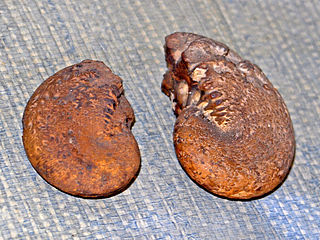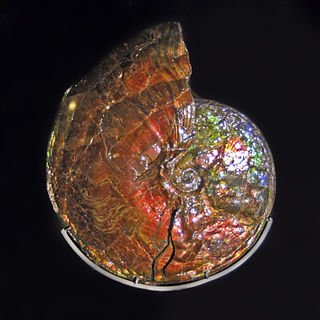
Ammonoids are extinct spiral shelled cephalopods comprising the subclass Ammonoidea. They are more closely related to living coleoids than they are to shelled nautiloids. The earliest ammonoids appeared during the Devonian, with the last species vanishing during or soon after the Cretaceous–Paleogene extinction event. They are often called ammonites, which is most frequently used for members of the order Ammonitida, the only remaining group of ammonoids from the Jurassic up until their extinction.

The Phylloceratina comprise a suborder of ammonoid cephalopods, belonging to the Ammonitida, whose range extends from the Lower Triassic to the Upper Cretaceous. Shells of the Phylloceratina are generally smooth with small to large umbilici and complex sutures with leaf-like phylloid saddle endings and lobes with thorn-like projections.
The Nautilina is the last suborder of the Nautilida and the only nautiloids living since the end of the Triassic. The Nautilina, proposed by Shimanskiy, is basically the Nautilaceae of Kummel, 1964, defined by Furnish and Glenister, but differs in omitting two families, the Paracenoceratidae and Pseudonautilidae which instead are placed in the Liroceratina.

Anagaudryceras is an extinct genus of ammonite from the later Cretaceous belonging to the Ammonoidea family Gaudryceratidae. Anagaudryceras has a moderately involute shell with a deep umbilicus and strongly ribbed outer whorl. Ribs are thick and rounded and cross over the venter uninterrupted.

Lytoceratina is a suborder of Jurassic and Cretaceous ammonites that produced loosely coiled, evolute and gyroconic shells in which the sutural element are said to have complex moss-like endings.

Ammonitina comprises a diverse suborder of ammonite cephalopods that lived during the Jurassic and Cretaceous periods of the Mesozoic Era. They are excellent index fossils, and it is often possible to link the rock layer in which they are found to specific geological time periods.

Placenticeras is a genus of ammonites from the Late Cretaceous. Its fossils have been found in Asia, Europe, North and South America.
Zetoceras is an extinct ammonoid cephalopod genus from the suborder Phylloceratina that lived during the Early and Middle Jurassic in what is now Europe, and is included in the (family) Phylloceratidae.
Heminautilus is an extinct genus of nautiloids from the nautilacean family Cenoceratidae that lived during the Early Cretaceous. Fossils of Heminautilus have been registered in rocks of Barremian and Aptian age. Nautiloids are a subclass of shelled cephalopods that were once diverse and numerous but are now represented by only a handful of species.

Phylloceratidae is the predominant family of the Phylloceratina with some 15 or more genera found in rocks ranging from the Lower Jurassic to the Upper Cretaceous. Members of the Phylloceratidae are characterized by smooth, involute shells with very thin walls. Many are covered with fine growth lines but are usually without ribbing. Sutures are complex with the major and minor branches of the saddles with phylloid or spatulate endings.

Tetragonitidae is a family of Cretaceous lytoceratin ammonites typically with square or trapezoidal whorl section at least during some growth stage. Members of this family are usually smooth but some lirate or striate, often with constrictions. Other features include suture with a varying number of auxiliary saddles, and an internal suture with two or more. Major saddles are irregularly trifid. The family is derived from the genus Tetragonites.
Pseudonautilidae is a family of Jurassic and Lower Cretaceous nautilid cephalopods belonging to the same superfamily as modern Nautilus, Nautilaceae, but forming a different branch from the family Nautilidae. Pseudonautilids, together with other nautilids, were contemporary with the ammonoids, which comprise an entirely different set of shelled cephalopod stocks more closely related to octopus and squid.

Hoplitoidea, formerly Hoplitaceae, is a superfamily of mostly Upper Cretaceous ammonites comprising families united by a similar suture pattern with multiple similar elements that tend to decrease in size going toward the umbilicus, at the inner edge of any whorl, and which are typically in a straight line. Sutural elements are commonly ammonitic, but in some saddles and in others both saddles and lobes are smooth and undivided. Shells are variable in form, both ribbed, evolute forms and smooth, involute forms are included.

Placenticeratidae is an extinct family of mostly Late Cretaceous ammonites included in the superfamily Hoplitoidea, derived from the Engonoceratidae by an increase in suture complexity.
Shloenbachiidae is a family of hoplitoid ammonoid cephalopds mostly from the lower Upper Cretaceous,.

Deltocymatoceras is an involute cymatoceratid (Nautilioidea-Nautilida) with broadly arched whorl sides, strongly convergent on a narrow venter that bears a slight, rounded, keel-like ridge, and with no distinct ventro-latera shoulders. Sides bear cymatoceratid ribs that bifurcate near the middle of the whorl sides, but do not cross the venter. The suture has a somewhat pointed ventral saddle, broad lateral lobes and prominent saddles on the umbilical shoulders. The position of the siphuncle in undetermined.

Hypophylloceras is a Cretaceous ammonite with a finely ribbed, compressed, involute shell; some having periodic stronger ribs or folds. The suture is complex, with large, asymmetric and finely divided lobes; the 1st lateral being much larger than the external (=ventral) and 2nd lateral lobes. Saddle endings commonly not phylloid.
The Barents Basin or East Barents Basin is a sedimentary basin underlying the eastern half of the Barents Sea. Lying off Russia on the continental shelf between the Kola Peninsula and Novaya Zemlya, it produces oil and gas.

Phyllopachyceras is an extinct genus of ammonoid cephalopods belonging to the family Phylloceratidae. These nektonic carnivores lived in the Cretaceous, from Hauterivian to Maastrichtian to age.
Flickiidae is a family of dwarf ammonites with little ornament and very simples sutures known from small pyritic specimens found in middle Cretaceous deposits. Inclusion in the Acanthoceratoidea is tentative.












